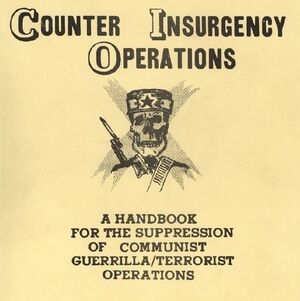A Handbook for the Suppression of Communist Guerrilla/Terrorist Operations (Chapter I)
| Author | Department of the Army |
|---|---|
| Country | United States of America |
| Subject | Counterinsurgency |
Publication date | 1961 |
| Text | A Handbook for the Suppression of Communist Guerrilla/Terrorist Operations online |
| Digital Identifier (JFK Library): JFKPOF-080-014 | |
| Part of a series on |
| Counterinsurgency |
|---|
CHAPTER I
ENVIRONMENT AND NATURE OF THE CONFLICT
a. Environment:
(1) Revolutionary Warfare although not restricted to the so-called underdeveloped areas has largely been waged in former colonial or semicolonial possessions and other areas having recently achieved national status or independence from totalitarian regimes.
(2) Salient characteristics of the area of operations have generally been:
(a) Undeveloped resources and industry with a marginal agrarian society based on a quasi feudal or colonial economic system.
(b) Considerable areas of the country that are sparsely populated due to conditions of geography. (Desert, mountain, forest and jungle.)
(c) Inadequate modern transportation, communication facilities and food distribution system.
(d) Marginal or low standard of living for the majority of the population.
(e) Periodic crop failure with accompanying famine or conditions of acute privation.
(f) High illiteracy rate, lack of educational institutions, hospitals and sanitation facilities.
(g) Majority of the wealth, industry and land concentrated in the hands of a small privileged class and/or foreign interests.
(h) Unstable government and immature political development. (i) Widespread graft and corruption in civil government, military establishment, police organization and political parties.
(j) Professionally substandard military and police establishments characterized by poor morale, organization, leadership, training, equipment and pay.
b. Nature of Conflict:
(1) Revolutionary Warfare is a total war waged throughout the country employing political, psychological, economic and military offensives alternately and together.
(2) The participation and support of the mass of the population is sought voluntarily or through the use of force and terror.
(3) No front, rear communication zone or area of a recognized noncombatant / nature exist in the normal military sense. The Rules of Land Warfare and Geneva Convention are generally not observed,
(4) The objective of the communists is not only the defeat and destruction of the government forces and the seizure of power but the. destruction of the political, religious, educational system and social economy of the target coxintry,
(5) To achieve their ultimate objective the communists attempt to:
(a) Enlist the active support of the population in attaining their goals by use of attractive reform and revitalization programs with the promise of land, more food, high standard of living, etc. Utilize the rapid growth of the Communist countries as modern industrial powers as an example to be emulated in the target country.
(b) Discredit the government in the eyes of the people as being tyrannical, corrupt and inefficient and representing the interests of the privileged classes to the exclusion of the people.
(c) Paralyse the economy and normal enterprise of the country,
(d) Prove to the population the inability of the government to protect the people, defeat the communists and insure conditions of normalcy by providing the necessary enforcement of law and order.
(e) Force the government to relinquish de-facto control of large portions of the country, its population and resources and confine themselves to purely defensive measures to assure control of key cities and centers of commerce and communications.
(f) Force the government to maintain abnormally large military and police establishments at the expense of the people and provoke the application of harsh and repressive measures to maintain order.
(6) Characteristics of the Conflict:
The following operational actions typify the tactics and techniques of Revolutionary Warfare:
(a) Guerrilla operations by armed communist bands in the field and the militant support of civilian subversive groups in urban areas.
(b) Extensive acts of sabotage against public property.
(c) Raids on military and police garrisons, convoys and depots.,
(d) Ambush and destruction of public and private transportation systems.
(e) Assassinations, terror bombings, kidnapping, torture and mutilation of prisoners.
(f) House burning, destruction of crops, expropriation of land and forced evacuation of villages.
(g) Payment of extortion ("voluntary gifts") by property owners and merchants for protection of their property.
(h) Bank robbery, counterfeiting and armed robbery to provide funds for the revolution.
(i) Extensive theft, expropriation and "liberation" of arms, food, clothing, medical supplies and marketable goods for barter.
(j) Use of kidnapping and hostage system on members of the families of key government personnel to assure their cooperation with the Reds.
